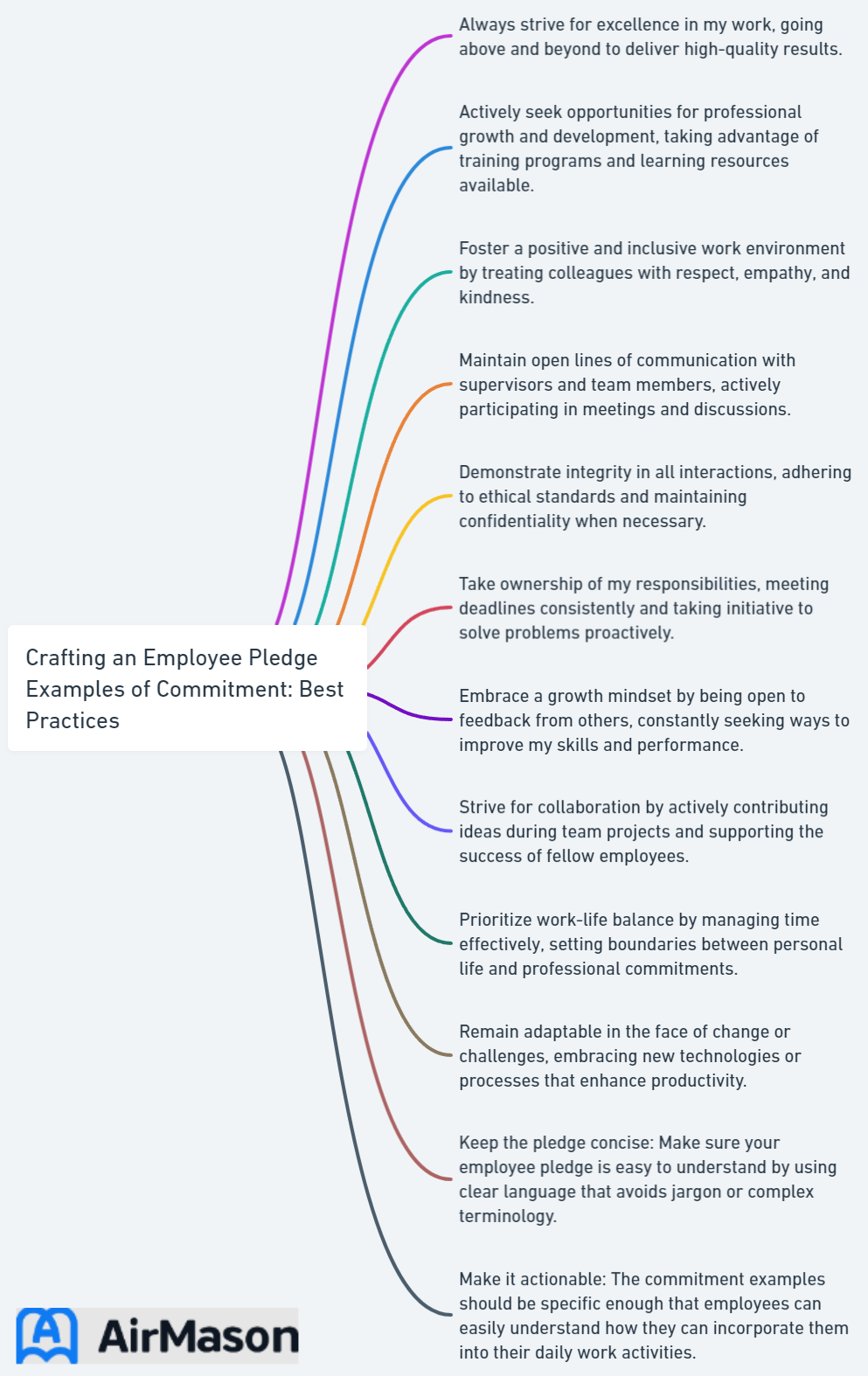
In today’s fast-paced and competitive business environment, a strong employee pledge can be a game-changer for organizations across various industries. Employee pledges serve as a foundation for creating a positive work culture, aligning employees with organizational goals, and fostering accountability and trust. Are you ready to unlock the full potential of your workforce? Dive into this comprehensive guide to understand the importance of employee pledge examples and learn how to create an effective one for your organization.
Key Takeaways
- Employee pledges are a powerful tool for boosting morale, aligning employees with organizational goals, and fostering trust and accountability.
- Essential elements of effective employee pledge examples include clear language, relevance to the organization’s values & culture, collaboration with employees in development & regular review/updating.
- Implementing an employee pledge requires communication of purpose & benefits, leadership support/role modeling, and progress monitoring & recognition.
Employee Definition
The term “employee definition” refers to the delineation of an individual’s professional status within an organization. In essence, the employee definition outlines the parameters and characteristics that classify an individual as a formal member of a workforce. This designation typically involves the establishment of a contractual relationship between the employer and the individual, encompassing rights, responsibilities, and expectations. Understanding the nuances of the employee definition is crucial for both employers and employees alike, as it sets the framework for legal, financial, and organizational considerations. Clear comprehension of the employee definition ensures that individuals are aware of their roles, benefits, and obligations, fostering a transparent and mutually beneficial working relationship within the organizational structure.
Understanding the Importance of Employee Pledge Examples
Employee pledges hold great significance. They serve as a powerful tool to boost morale, align employees with organizational goals, and encourage accountability and trust within the workplace. A well-crafted pledge can positively impact employee satisfaction, performance, and overall success of the company.
But how exactly do employee pledge examples contribute to fostering such a thriving work environment?

Boosting Employee Morale and Engagement
A well-formulated employee pledge can play a significant role in enhancing the morale and engagement of the workforce. By fostering a sense of belonging and advocating organizational values, employees feel more connected to the company and its mission. This heightened sense of connection and satisfaction ultimately bolsters employee engagement and contributes to the organization’s success.
Moreover, employee pledges often establish expectations for maintaining a positive work environment, which can be instrumental in creating a workplace that employees enjoy coming to daily, as long as the employer agrees to uphold these expectations.
Aligning Employees with Organizational Goals
Aligning employees with organizational goals through employee pledges is crucial for creating a united team, leading to increased productivity and talent retention. When employees understand how their individual goals and responsibilities align with the organization’s objectives, they are more likely to work in harmony and support each other’s efforts, fostering trust and cooperation.
A well-aligned team contributes to the overall success of the company by driving performance improvement and adapting to changing circumstances in the industry.
Encouraging Accountability and Trust
Employee pledges play a pivotal role in fostering a culture of accountability and trust within the organization. Establishing clear expectations, promoting open communication, and demonstrating a commitment to organizational values can help cultivate a trusting work environment where employees feel empowered to take initiative and responsibility for their actions.
Moreover, a well-defined commitment pledge helps employees understand the consequences of not abiding by the commitment, which can further enhance their sense of accountability and ownership.
Essential Elements of Effective Employee Pledge Examples

A successful employee pledge hinges on three key elements: clarity of language, relevance of content, and mirroring organizational values and culture. By incorporating these elements in your employee pledge, you can establish a strong foundation for employee commitment and engagement, fostering a positive work environment where employees feel motivated to contribute to the organization’s success.
Clear and Concise Language
Using clear and concise language in employee pledges ensures that employees understand their commitments and expectations. Ambiguity can lead to misunderstandings and confusion, which can negatively impact employee commitment and enthusiasm. By employing clear and precise language, you can avoid these issues and guarantee that employees comprehend their duties and adhere to the pledge.
Ultimately, clear language and maintaining eye contact bolsters credibility and encourages ethical conduct by establishing explicit expectations for employees.
Relevant and Inclusive Content
Ensuring that the content of employee pledges is relevant and inclusive helps create a positive and diverse work environment. By incorporating diverse perspectives and addressing the unique needs of employees, you demonstrate respect for cultural diversity and equality, fostering a positive work culture that embraces and supports all employees.
Moreover, inclusive content allows employees from different backgrounds to feel heard and valued, which can contribute to increased engagement and commitment to the organization’s goals.
Reflecting Organizational Values and Culture
Employee pledges should reflect the organization’s values and culture to ensure that employees align with the company’s principles and foster a sense of unity. By specifying the expectations of the employee in terms of behavior, attitude, and performance, and including language that reflects the organization’s dedication to its employees, you can create a pledge that resonates with the workforce and motivates them to uphold the company’s values and culture.
Ultimately, a pledge that reflects the organization’s values and culture helps create a cohesive and committed team working towards a shared goal.
Tips for Creating Impactful Employee Pledge Examples

There isn’t a one-size-fits-all approach when it comes to crafting an impactful employee pledge. There are various factors to consider and adapt based on the unique needs and values of your organization. Here are some practical tips to help you develop an effective employee pledge that resonates with your workforce and drives positive change: collaborate with employees, regularly review and update the pledge, and provide training and support.
Collaborate with Employees
Involving employees in the development of an employee pledge is essential to ensure that their feedback and viewpoints are taken into account, leading to a more effective and purposeful pledge. Collaboration fosters a sense of ownership and loyalty to the organization, as employees feel valued and heard.
By incorporating employee input, you can create a pledge that is more meaningful and influential for the entire organization, ultimately fostering a stronger commitment to the pledge’s goals and values.
Regularly Review and Update
An employee pledge should be reviewed and updated at least annually to ensure its relevance and alignment with evolving circumstances and objectives. Regular review and updates provide an opportunity to reinforce the organization’s expectations and standards, thus promoting consistency and alignment among employees.
Keeping the pledge up-to-date and relevant not only helps maintain its effectiveness but also demonstrates the organization’s commitment to continuous improvement and adaptation. It’s essential to follow up on the progress to ensure the pledge remains meaningful.
Organizational Standards Examples
When establishing a thriving workplace, it’s crucial to define clear organizational standards. Organizational standards examples encompass guidelines for communication, ethical behavior, and performance expectations. These benchmarks provide employees with a framework to understand the company’s values and expectations. For instance, punctuality, respect in communication, and quality of work are common organizational standards examples. Regularly revisiting and reinforcing these standards fosters a positive work culture and ensures everyone is aligned with the organization’s goals.
Provide Training and Support
Providing training and support for employees regarding the pledge helps them understand their commitments and fosters a culture of continuous improvement. Training programs that educate employees on specific aspects of the pledge, such as values, behaviors, and expectations, can help them internalize the pledge and effectively implement it in their daily work.
By offering ongoing support and resources, you can assist employees in fulfilling their pledge commitments and ultimately contribute to the organization’s success.
Real-Life Employee Pledge Examples

To further illustrate the versatility and effectiveness of employee pledges, let’s take a look at some real-life examples from a tech company, healthcare organization, and non-profit organization. These examples demonstrate how different industries can successfully implement employee pledges to drive success and maintain a positive work environment.
Example 1: Tech Company
In the tech industry, an employee pledge might focus on innovation, collaboration, and ethical behavior to drive success and maintain a positive work environment. The tech company’s pledge would emphasize the importance of employees working together to develop cutting-edge solutions while adhering to the highest ethical standards.
By fostering a culture of innovation and collaboration, the company can position itself as a leader in the industry and attract top talent who are passionate about making a difference through technology.
Example 2: Healthcare Organization
A healthcare organization’s employee pledge might emphasize patient care, teamwork, and continuous improvement to ensure high-quality service and a supportive workplace. The pledge would outline the organization’s commitment to providing exceptional care to patients and working as a cohesive team to achieve the best possible outcomes.
Furthermore, continuous improvement would be a key component of the pledge, encouraging employees to actively seek opportunities to enhance their skills and contribute to the organization’s performance improvement and quality improvements efforts.
Example 3: Non-profit Organization
In a non-profit organization, the employee pledge might highlight commitment to the cause, integrity, and inclusivity to foster a passionate and dedicated workforce. The pledge would emphasize the organization’s mission and values, encouraging employees to actively engage in activities that support the cause and uphold the highest ethical standards.
Moreover, the pledge would promote inclusivity, ensuring that all employees feel valued and respected, regardless of their background or abilities.
Implementing Employee Pledge Examples in Your Organization

Now that you have a better understanding of employee pledge examples and their importance, it’s time to implement them in your organization. To do so effectively, consider the following steps:
- Communicate the purpose and benefits of the pledge to your employees.
- Encourage leadership support and role modeling.
- Monitor progress and recognize achievements related to the pledge.
By taking these steps, you can create a strong foundation for employee commitment and engagement, fostering a positive work environment where everyone feels motivated to contribute to the organization’s success.
Communicate the Purpose and Benefits
Clearly communicating the purpose and benefits of employee pledges helps employees understand their importance and fosters a sense of shared commitment. By articulating the rationale for implementing the pledge and the benefits that employees can gain from participating, you create a strong foundation for employee motivation and commitment to the organization’s goals.
Be sure to use clear, concise language and tailor your communication to the specific needs and values of your organization and employees, ensuring that everyone understands the purpose and benefits of the sample pledge.
Encourage Leadership Support and Role Modeling
Leaders play a crucial role in driving employee pledge adoption and creating a culture of accountability and commitment throughout the organization. Encouraging leadership support and role modeling of the employee pledge helps create a culture of accountability and commitment throughout the organization, as leaders set the tone for their team members and demonstrate the importance of upholding the pledge in their daily actions.
By leading by example and providing support and guidance, leaders can foster a sense of unity and dedication to the pledge within their teams.
Monitor Progress and Recognize Achievements

Monitoring progress and recognizing achievements related to the employee pledge is essential for maintaining momentum, encouraging continuous improvement, and celebrating success. By tracking pledge-related accomplishments and offering recognition and rewards for those who exceed expectations, you can create an environment where employees feel motivated to uphold the pledge and contribute to the organization’s success.
Employee Expectations
Employee expectations play a pivotal role in fostering a positive work environment. Understanding and managing employee expectations is crucial for both employers and team members. Clear communication and setting realistic goals are essential to align employee expectations with organizational objectives. Regularly revisiting and discussing these expectations can help build trust and enhance employee satisfaction. By actively addressing and managing employee expectations, organizations can create a workplace culture that promotes engagement and productivity.
Summary
In conclusion, employee pledges are a powerful tool for promoting a positive work environment, aligning employees with organizational goals, and fostering accountability and trust. By understanding the importance of employee pledge examples, incorporating essential elements, and implementing best practices, you can create an effective pledge that resonates with your workforce and drives positive change. It’s time to unlock the full potential of your employees and propel your organization toward success.
Frequently Asked Questions
What are employee pledges of commitment?
Employees are expected to make a Pledge of Commitment, declaring their dedication to upholding their employer’s values, goals and expectations. This serves as a reminder of their responsibilities, guiding their behavior and demonstrating commitment to the organization.
What is an example of a company pledge?
At ABC Company, we pledge to keep our employees and customers safe by providing flexibility, proper training, education and clearly communicating policies and procedures.
What are the main benefits of having a strong employee pledge in place?
Having a strong employee pledge in place can help to foster better team dynamics, drive employees to achieve organizational goals, and build trust between colleagues.
How can I ensure that my employee pledge reflects my organization’s values and culture?
Involve employees in the process, use concise language, and ensure the content resonates with your workforce to create an effective employee pledge that reflects your organization’s values and culture.
How often should I review and update my organization’s employee pledge?
It is recommended to review and update your organization’s employee pledge at least annually to keep it up-to-date and aligned with current objectives.